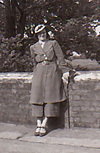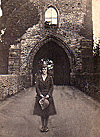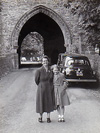 A
little bit of Amy's history.
A
little bit of Amy's history.In late April, Amy came over from France and she thought it would be interesting to see where some of her Great grand parents came from.
Born in 1995, Amy lived mainly in St.Annes in Lancashire before moving out to France with her mum, Claire.
Father
 Amy's
dad, Ian, born 1967 was 28 years old when he had Amy. He spent his childhood in Croston, in Lancashire. Croston was a village mentioned in the doomsday book
and was in existence from before the 10th
century.
Amy's
dad, Ian, born 1967 was 28 years old when he had Amy. He spent his childhood in Croston, in Lancashire. Croston was a village mentioned in the doomsday book
and was in existence from before the 10th
century.
Ian was mad about computers, he went to collage & followed his hobby to work with computers in the IT industry.
Grandfather
 His
dad, Frank born 1938, (Amy's granddad) had Ian when he was 29 and he spent most of is
childhood in Manchester. Married to Kathleen, after meeting in the RAF, he
became a salesman, spending most of his life selling around the north of
England.
His
dad, Frank born 1938, (Amy's granddad) had Ian when he was 29 and he spent most of is
childhood in Manchester. Married to Kathleen, after meeting in the RAF, he
became a salesman, spending most of his life selling around the north of
England.
Great Grandmother
 Franks
mother, Florence, born 1911, (Amy's great grandmother) was 27 when she had him & came
originally from Whalley in Lancashire and was a Hebden. She left school at 14 &
like most of her family, went into the cotton trade as a spinner in the village.
She married Arthur, who, becoming a civil servant, moved them to Manchester. All
Frank's school holidays, from about 9 years old, were spent with his Grandparents at their cottage at 2 Poole End, in Whalley. A two up, two down, mid
terrace cottage built in the Tudor era, where her parents raised 5 kids.
Franks
mother, Florence, born 1911, (Amy's great grandmother) was 27 when she had him & came
originally from Whalley in Lancashire and was a Hebden. She left school at 14 &
like most of her family, went into the cotton trade as a spinner in the village.
She married Arthur, who, becoming a civil servant, moved them to Manchester. All
Frank's school holidays, from about 9 years old, were spent with his Grandparents at their cottage at 2 Poole End, in Whalley. A two up, two down, mid
terrace cottage built in the Tudor era, where her parents raised 5 kids.
Gt.Gt. grandmother
 Florence's mother, Nellie (Gooderham), born 1886 (Amy's great great grandmother) had Florence aged 25.
Married to Billy Hebden, a bus driver for the Ribble bus company. So far was
Frank remembers, Nellie never worked outside the home. She helped raise Frank
over all those school holidays. Still living at home was her youngest son
Kenneth. A wonderfully kind & generous women, she died in 1954 of
cancer, just after Frank had started work at the age of 15.
Florence's mother, Nellie (Gooderham), born 1886 (Amy's great great grandmother) had Florence aged 25.
Married to Billy Hebden, a bus driver for the Ribble bus company. So far was
Frank remembers, Nellie never worked outside the home. She helped raise Frank
over all those school holidays. Still living at home was her youngest son
Kenneth. A wonderfully kind & generous women, she died in 1954 of
cancer, just after Frank had started work at the age of 15.
Gt x 3 Grandmother
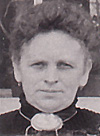 Nellie's
mother Mary, born 1852 (Amy's great great great grandmother) was relatively old at 34 when
she gave birth to Nellie. We know that in 1901 she was a cotton winder and her
children were all cotton weavers, from the census returns in 1901. (Nellie was
14 then) Mary's nee name was Lund. She was born in
Shipley Yorkshire. Her husband, George Gooderham, was a railway worker. He was killed on
Whalley railway arches, in 1907. George seemed to have followed the great
expansion of the railways, as he was born in Bressingham, Norfolk.
Nellie's
mother Mary, born 1852 (Amy's great great great grandmother) was relatively old at 34 when
she gave birth to Nellie. We know that in 1901 she was a cotton winder and her
children were all cotton weavers, from the census returns in 1901. (Nellie was
14 then) Mary's nee name was Lund. She was born in
Shipley Yorkshire. Her husband, George Gooderham, was a railway worker. He was killed on
Whalley railway arches, in 1907. George seemed to have followed the great
expansion of the railways, as he was born in Bressingham, Norfolk.
Our trip
All of them lived a lot of their lives in Whalley. We thought it would be nice to see this lovely Lancashire village where Frank spent his holidays, where Florence was born. as well as Nellie
 The first place we visited as Spring wood. A place where Florence used to go
to pick the bluebells & take them back to Manchester. Of course, that's illegal
now, so we just took photographs! Spring Wood was once owned by
the monks of Whalley Abbey and was originally called Oxheyewoode, which formed
part of a deer park. In the 1530’s the monasteries were dissolved and all the
possessions were seized by the Crown. On the 6th June 1553 nearly all the land
that belonged to the Abbey was sold by Edward VI to Richard Assheton, Esq. and
John Bradyll, Gentleman for the sum of £2,132 3s 9d. This included Oxheyewoode.
The woods location was described as 'one bow shot East of the Abbey'. Now it is
a lovely picnic area, full of nice walks, wild life & a waterfall and small
lake.
The first place we visited as Spring wood. A place where Florence used to go
to pick the bluebells & take them back to Manchester. Of course, that's illegal
now, so we just took photographs! Spring Wood was once owned by
the monks of Whalley Abbey and was originally called Oxheyewoode, which formed
part of a deer park. In the 1530’s the monasteries were dissolved and all the
possessions were seized by the Crown. On the 6th June 1553 nearly all the land
that belonged to the Abbey was sold by Edward VI to Richard Assheton, Esq. and
John Bradyll, Gentleman for the sum of £2,132 3s 9d. This included Oxheyewoode.
The woods location was described as 'one bow shot East of the Abbey'. Now it is
a lovely picnic area, full of nice walks, wild life & a waterfall and small
lake.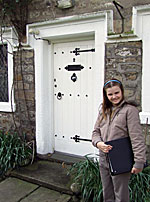
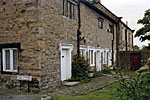 Then it was into Whalley, turn up Church lane to see Pool End ahead of us. The
first change was ... no where to park. Frank tried to show how the tiny village
school had been extended & added too, in all directions. This was where Florence
used to be the last in line when the school bell sounded, she just lived across
the road! Billy & Nellie lived in this grade II stone cottage opposite the Church
in Whalley. They had No. 2. The cottage was known about, in the mid 17th century
& was connected to Whalley’s Cistercian Abbey. Originally,
it was one house and was later made into three cottages. To the rear we could see a
door that had been sealed up generations ago. No one was home but we
managed to look around & see that it was all basically the same. The
outside toilets in the garden were looking worse for wear & the Lilac tree
had been cut down. Later on I asked the owners of number one Poole End, they
said it was killed off by wrong pruning. How sad, that tree had lasted so long
& given so much pleasure. Although it was covered with black sheeting, we could
see the tree was struggling to send up shoots around the edges. I wonder
if it will come back one day.
Then it was into Whalley, turn up Church lane to see Pool End ahead of us. The
first change was ... no where to park. Frank tried to show how the tiny village
school had been extended & added too, in all directions. This was where Florence
used to be the last in line when the school bell sounded, she just lived across
the road! Billy & Nellie lived in this grade II stone cottage opposite the Church
in Whalley. They had No. 2. The cottage was known about, in the mid 17th century
& was connected to Whalley’s Cistercian Abbey. Originally,
it was one house and was later made into three cottages. To the rear we could see a
door that had been sealed up generations ago. No one was home but we
managed to look around & see that it was all basically the same. The
outside toilets in the garden were looking worse for wear & the Lilac tree
had been cut down. Later on I asked the owners of number one Poole End, they
said it was killed off by wrong pruning. How sad, that tree had lasted so long
& given so much pleasure. Although it was covered with black sheeting, we could
see the tree was struggling to send up shoots around the edges. I wonder
if it will come back one day.
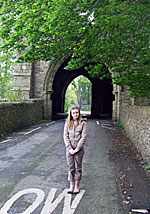 A walk around the church yard was very sad. The church was locked & the grave of
Billy, Nellie & their son Billy had been vandalised,
A walk around the church yard was very sad. The church was locked & the grave of
Billy, Nellie & their son Billy had been vandalised,  along with many other
graves at the bottom end of the graveyard. A sad indictment on a rich
community. Amy saw, what she thought was a horse trough, which turned out to be
a very ancient stone coffin.
along with many other
graves at the bottom end of the graveyard. A sad indictment on a rich
community. Amy saw, what she thought was a horse trough, which turned out to be
a very ancient stone coffin.
The history of Whalley Abbey goes back a loooong way! The Cistercian Abbey of Stanlow, in Cheshire, moved to Whalley in 1296. The Church was built from 1330 to 1380, but the Abbot’s Lodging and Infirmary was not completed until c.1440. At the dissolution of the Monastery in 1537, the property passed into private hands, and Ralph Assheton adapted it to make an Elizabethan Manor House. It remained a private residence until 1923, when the Church of England acquired possession.
We drove down to the Abbey gatehouse by the railway arches. It was looking good, a fair state of repair. We both wondered how long it would take men in the 15th. century, to build this. It was, after all, the front door to the Abbey. We also wanted to stop in the village to look around the main street, but today, its so difficult to park. Amy got her picture on the bridge over the River Calder, where Florence had stood so long ago.
It was a trip worth taking, the people we saw had disappointed us, with their apparent standoffishness. It was sad to see the church as it is but it remains a beautiful place of very fond memories.
2010
It was in April once again, when we carried on tracing the family connections & links with Yorkshire.
Gt. x 4 grandfather
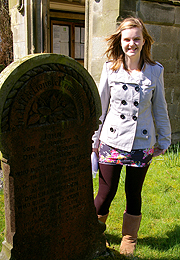 Robert
Hebden, the father of Billy Hebden (who married Nellie) was born in Buckden in 1862 the Wharfedale
valley, north of Grassington. He had left mining & moved to Whalley, marrying
Dinah Rydeheard & lived in Poole End.
Robert
Hebden, the father of Billy Hebden (who married Nellie) was born in Buckden in 1862 the Wharfedale
valley, north of Grassington. He had left mining & moved to Whalley, marrying
Dinah Rydeheard & lived in Poole End.
His father, Robert was born in 1825 in Grassington but moved to Hebden to marry
Drusilla Sherrington in the church there in 1851. This is where we began seeing
real connections. 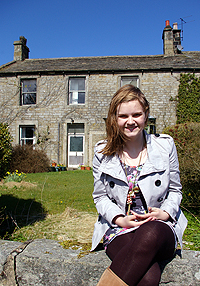
The name Hebden is considered to be derived from either heope, Old English for a rose-hip or heopa, Old English for a bramble, and dene, Old English for a valley. Two Bronze Age stone circles and remnants of huts on the moors above the village show that the area has been settled since earliest times and place names such as Scale Haw show that the Norse left their influence but there is no documentary record of the area until a brief mention in the Domesday Book of 1086, in which it was referred to as Hebedene.
Todays trip
We sat in the old school house, now a cafe, eating our lunch. It was slow coming but nice when we go it. The sunshine brought us tourists out & it was packed. It was the same room where, a hundred & thirty six years before, her relatives had been taught, as it opened in 1874.
Gt. x 5 Grandfather
We found the grave stone of Robert, Drusilla & their son John (who died at 24) right outside the church door of St. Peter's. On census return for 1851 Robert is living with a John Jelson in Hebden as a lead ore dresser, listed as unmarried & a lodger. In this year his trade becomes a lead miner when he marries Drusilla, on Christmas day, in Hebden. He became, Mr. Robert Hebden, Hebden Hall, Hebden, Yorkshire, after he rented what became a semi detached house! Not nobility or a land owner, but a lead miner trying to earn a living the hard way!
Gt. x 6 Grandfather
His father, William, was agricultural labourer. Amazingly, although her father was a school master, They both signed with an X. So much for teaching daughters to read & write in 1851! Lead mining seemed precarious, at various census returns he is in farming. But in 1881 he is back in Hebden, living at Hebden hall as a lead miner with four children.
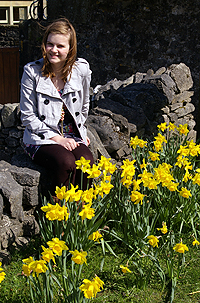 To put this into an era in time, in 1825 King George the IV was on the throne &
John Quincy Adams is the President of the USA. Beethoven had only two years to
live. They were shipping convicts to Brisbane, Australia. Railway transportation
was born in 1825 when Stephenson's 'Locomotion' ran from Darlington to Stockton,
carrying 450 persons at 15 miles per hour. London had started the first horse
drawn
To put this into an era in time, in 1825 King George the IV was on the throne &
John Quincy Adams is the President of the USA. Beethoven had only two years to
live. They were shipping convicts to Brisbane, Australia. Railway transportation
was born in 1825 when Stephenson's 'Locomotion' ran from Darlington to Stockton,
carrying 450 persons at 15 miles per hour. London had started the first horse
drawn 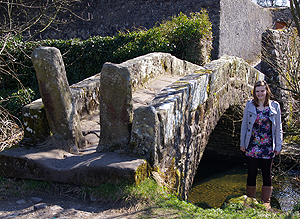 Omnibus services. He shares his birthday with Johann Strauss. By the time
he was ten, Charles Darwin was on the Beagle doing his historic stuff that led
to the famous "Origin of species" The following year, the Alamo was lost to the
Mexicans, killing Davey Crocket & Jim Bowie.
Omnibus services. He shares his birthday with Johann Strauss. By the time
he was ten, Charles Darwin was on the Beagle doing his historic stuff that led
to the famous "Origin of species" The following year, the Alamo was lost to the
Mexicans, killing Davey Crocket & Jim Bowie.
We then went on to the lovely village of Linton, not 1 mile away from Grassington.
Gt. x 7 & 8 Grandfathers
William Hebden, Robert's father, was born in the Horton Parish of Ingleton in 1792, to Robert & Jane (nee Geldhard, who had 8 children. They were all born in the Ingleton area. 1792 was the reign of George III, William Pitt the younger was Prime Minister (the guy who started income tax, to pay for the Napoleonic wars), George Washington was America's first President & Napoleon was Emperor of France. Its two years before the Napoleonic Wars & The French Revolution finished that year. The Industrial Revolution was about to occur. Mozart had died the year before, James Watt was well into improving his steam engines. It was 1792 that gas was used to illuminate houses so it was candle power for the masses still.
By the time William as six, Nelson had beaten the Spanish fleet at Cape St. Vincent, by the time he was a teenager, the Battle of Trafalgar had been fought.
 He
married Ann in 1825 in the very old church of St Michael & All Angels at Linton.
It has Saxon origins from about 850 AD. Although many alterations and additions
have been carried out over the years, the font is thought to be a genuine Norman
one, and other parts of the building certainly date from 1150. At his wedding he
was a labourer and could write his name, a thing his son couldn't do.
He
married Ann in 1825 in the very old church of St Michael & All Angels at Linton.
It has Saxon origins from about 850 AD. Although many alterations and additions
have been carried out over the years, the font is thought to be a genuine Norman
one, and other parts of the building certainly date from 1150. At his wedding he
was a labourer and could write his name, a thing his son couldn't do.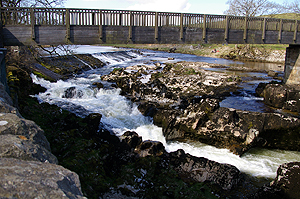
Linton is now a tourist area where many love to walk by the famous falls. Amidst the group of cottages close by the Falls we found the stunning, 14th Century, packhorse bridge called 'Little Emily's Bridge', a few minutes' walk from the church. Standing by that bridge, you thought that very little could have changed on that spot. Many relatives footsteps must have gone past there & their hands must have rested on the same two standing stones that Amy touched as she crossed over.
At Roberts baptism, William is a miner in Cupola but he didn't stay a miner. He seems to have many jobs over his life but I would think "labourer" may mean that he turned his hand to anything available, not always agricultural. The Grassington area has always been mining or farming. In 1827 he is a shepherd at Gill house north of Grassington. 1851 he is in Hebden as agricultural labourer with his children working as lead ore dressers at the mines. At Roberts wedding, he was also a labourer. In 1861 he is in Linton as a labourer, still working at 68.
We had a lovely day, full of sunshine, family history & daffodils. Amy managed to stand on the exact spot in two churches where her 4th & 5th great grandmothers, Drusilla & Ann said "I do" to Robert & William Hebden. In the case of William & Ann, that was 185 years ago!
